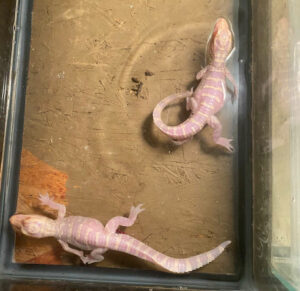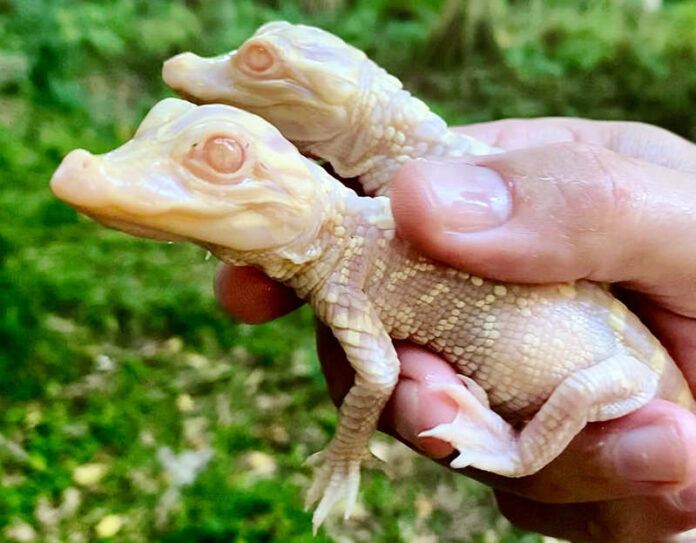A Florida zoo has shared a photo of two baby albino alligators that hatched only recently.
The two young alligators, which have white scales all over their bodies, are “thriving,” according to the Wild Florida zoo.
The hatchlings are from a breeding pair of albino alligators that the zoo houses called Snowflake and Blizzard. The new babies can be seen below.
The zoo acquired the breeding pair, who were originally from the St. Augustine Alligator Farm, in 2017.
Because their skin lacks melanin, the two alligators are sensitive to sunlight, so the zoo constructed a climate-controlled exhibit with lots of shade.
It’s not the first time the two large reptiles have produced offspring, having done so last year as well.

This year’s two new babies were hatched from a batch of 18 albino alligator eggs that were collected earlier in the summer from Snowflake and Blizzard and then incubated.
Sam Haught, co-owner and co-founder of Wild Florida, told Newsweek: “There are less than 200 albino alligators in the world and we’re so lucky now to have a total of 8 here at Wild Florida. 4 babies were hatched in 2020 and 2 more this year.
“We can’t believe our superstar couple Blizzard and Snowflake have produced so many baby albinos under our care. These babies are the world’s only albino gators hatched at an attraction.”
In a video posted on the zoo’s Facebook page, Wild Florida zoo staff members showed how small the new hatchlings are compared to one born last year.
Andrew, one of the staff members, said: “We’re really excited, we have these guys in the back right now, we’re taking really good care of them, making sure they’re doing really good, and then before long we’ll have them out on exhibit too.”
From their nose to the tip of their tail, male albino alligators average between 10 and 15 feet while females average between eight and 10, according to Wild Florida. Males also tend to weigh more than females, coming in at around 500 pounds. Females average about 200 pounds.
Their diet consists mainly of fish, turtles, snakes and small mammals.
Non-albino American alligators may live up to 75 years in human care, though the oldest albino alligator on record is a 25-year-old individual named Claude at the California Academy of Sciences in San Francisco, Wild Florida states.
Albinism is the result of cells that don’t produce melanin, the pigment that gives color to eyes, scales, hair and skin. It is a genetic condition that gets passed on when both parents carry the recessive gene, according to the Iowa Department of Natural Resources. Albinism also affects humans.
Culled: Newsweek



















![Legacy in Continuity: How Gbenga Daniel’s Vision Still Shapes Ogun State’s Development [FEATURE] newsheadline247/Gbenga Daniel](https://newsheadline247.com/wp-content/uploads/2019/03/newsheadline247-Gbenga-Daniel-e1553985504695.jpg)






